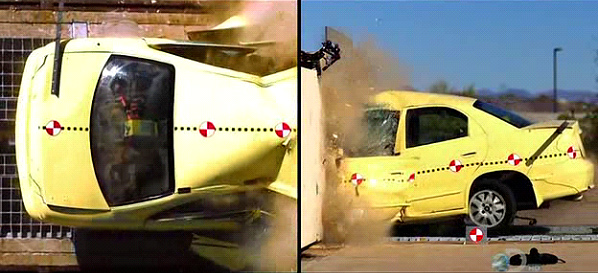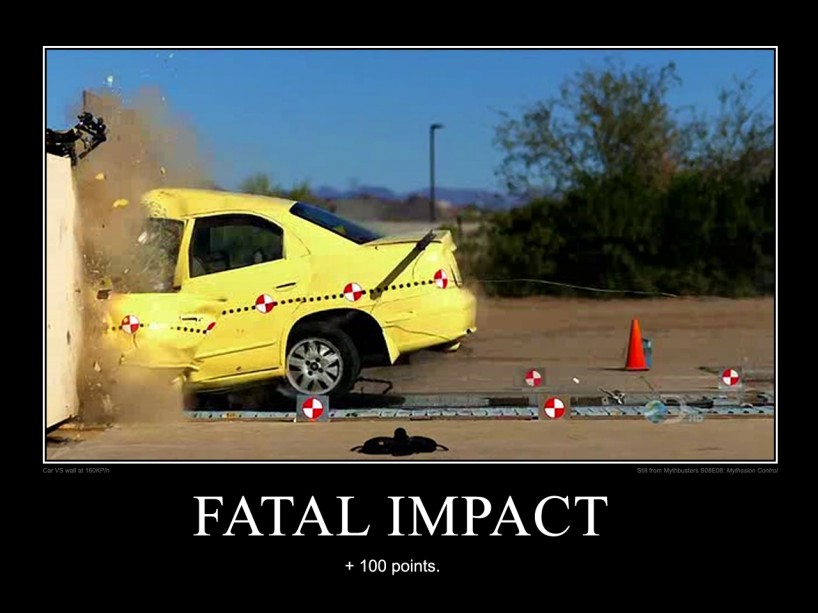Game Concept: ‘Impact’
14 Mar, 2011
This concept was written for the Advanced Computer Game Design (MDDN343) at Victoria University in 2011. I’d love to see it realised!
Vehicle simulation with an arcade core, but with a distinctive lack of sprites. Impact fuses together arcade-style challenge and scoring with intensely real vehicle simulation, a bit of humour, and some serious underlying themes for those who like greater meanings. Not a fan of racing games? – Good, because this game is all about crashing.
Real-to-life, dynamic vehicle crash simulation is at the driving heart of this concept, though scoring systems and a variety of challenges keep it in the realm of games over ‘serious physics simulations’. In Impact, the player pilots a vehicle in a three-dimensional, semi-open environment where they must ultimately crash the vehicle to earn points and achieve goals. Points are awarded for the extent of damage to different vehicle components and can also be awarded for completing bonus objectives. Short, separate challenges or ‘levels’ are built-up using a variety of constraints, obstacles and goals, and slot over the simulation framework allowing for almost infinite iterations of tightly-woven player experiences. As the player’s primary point of interaction and the foundation of the scoring system, accurate vehicle crash simulation is the cornerstone of Impact.
While the term ‘accurate vehicle simulation’ suggests a mighty-complex physics model and a lot of heavy computation, accuracy in the context of this game is about satisfying the player – not a scientist. As long as collisions and visual damage are believable and satisfying to the player, the underlying skeleton of the simulation can be an array of box-model estimations and triggers representing a vehicles main components. This pseudo-complexity simplifies the simulation model to a sensible game level and richens gameplay with increased dynamic possibilities. Playable as a stand-alone entity, the vehicle and crash simulation of Impact relies on a solid scoring system driven by crash data to make the step from interactive physics demonstration to game.
Equally as important as its core simulation mechanic, Impact’s scoring system gives worth to collisions and creates a further framework for levels and challenges to perch on. A workable array of floating-points representing the damage of each simulated vehicle component is fed into the scoring system, where it is further refined, and returned to the player as points (score) and short written messages. Each vehicle component is assigned a worth in points primary based on ease of destruction, and any damage reported by the simulation is awarded as a factor of component damage (0. – 1. ) and component value. It is undecided whether points should be awarded cumulatively (where each time a damage value changes the new factor is added to the current score, and a component can give many times its value in points) or relatively (where a part can only give the total value it has been assigned, and score is calculated from the current damage of every component with every change).
Relatable information is given to the player by segmenting component damage (as 0. - 1. ) into several stages and alerting the player when damage has reached a segment. For example, “unharmed” (0.), “scratched”( > 0. & < 0.1), “damaged” ( > 0.1 & < 0.4), “critically damaged” ( > 0.4 & < 0.8), and “obliterated” ( > 0.8) could give an on-screen message like: “Front Bumper Obliterated”. Reaching certain damage segments on any component or specific components could also result in additional fixed-value rewards. Each segment adjective could be exchanged for a more appropriate alternative if necessary (i.e. a tire being “scratched” doesn't sound right) or randomly taken from a pool of generic alternatives to reduce monotony - “disintegrated”, “shredded”, “vaporised”, and “destroyed” could be variations of “obliterated”. This text-based feedback creates a simple point of reference between challenges and allows the player to quickly understand the scoring system and the result of their collision. As many different components could simultaneously send text feedback in a collision, it would be wise if feedback was separated on the player's HUD into an area for important messages and a smaller, dimmed stream for everything else. Each message could also be assigned a priority, so that minor messages would show in the important stream until higher priority messages push them to the general stream.
In addition to the attribution of individual component damage to score, multiple components can be analysed as groups to define broader levels of damage and bonus objectives. As the most relatable form of feedback over that of any individual component, bonuses like “Fatal Impact +1000” (for killing the driver) are not only emotive and rewarding, but present an extra layer of challenge and incentive to the player on top of what a level demands. Bonus objectives and point awards can similarly be triggered from data besides component damage: vehicle speed, angle of impact, and speed of impact to name a few. A scoring system of points, individual component damage, and bonus objectives bind to the raw simulation of Impact to put in the realm of 'game', but also provide a solid framework for levels and challenges to expand upon.
Levels and challenges are the interchangeable icing on the cake that is Impact, giving direction to the game and player through sets of defined goals and constraints. Goals power the game from the top up – giving a reason to play, and using the game's systems to make play possible and rewarding.
With a firm scoring system underfoot, challenges can easily be created by taking possibilities of the scoring framework and marking them as goals or events that must not occur (constraints). To win a player must achieve all goals while keeping within constraints. Challenges can be presented raw (i.e. “Achieve more than X points without damaging Y”) or as a scenario where additional non-standard features may be added. For example: “A masked gunman has entered your vehicle and is sitting in the front passenger seat ordering you to drive. You must kill the gunman by crashing, but make any obvious moves and he'll shoot! You must survive as there's pizza waiting for you at home”. In this scenario the goal is to kill the front-seat passenger and the constraints are that the driver must survive, and a custom meter (probably based on latitudinal g-force and steering delta) must not be maxed-out. Without a defined challenge the game defaults to a 'crash to earn maximum points' goal. An enormous number of goal and constraint combinations can be blended to offer different types of challenge within the same gameplay model, but without an engaging and relevant environment, the gameplay falls to pieces.
Environment plays an important roll in both setting the theme of the game and allowing physical difference between challenges. Impact is set at a crash testing facility where arenas designed for different outcomes – a long narrow track for high-speed impact for example – exist in a single environment. Challenges can isolate the player to an arena with location constraints, and the placement of themed objects like highway barriers, cones, ramps and poles, as well as unreal objects like large vertical wedges, spikes, and tank-busters can provide physical points of difference between challenges. The environment substantial enough that it is not dependant on challenge defined objects to create variation, but object placement allows a greater number of challenge possibilities.
Challenge variation is topped off with sprinkles in the form of multiple vehicle choices. A range of generic, classed vehicles adds depth to the game by giving the player multiple interactions to master. Though all vehicles would use the same control scheme, differences in handling, power, physical structure, strength and vehicle specific crash bonuses provide different experiences. A single generic vehicle from each of the following classes might be available: car (sedan, hatch-back, wagon, and convertible), 4x4, van, city/delivery truck, and semi-truck. All things considered, a rich array of challenges, and a rewarding and relatable scoring system move Impact firmly to the 'game' category, but is there more to it than meets the eye?
Impact relies on real-to-life vehicle collision simulation and analysis of damage incurred to report to the player, amongst other things, fatalities. While it may seem politically-incorrect to simulate and even challenge a player to crash a vehicle killing its occupants, the game is not intended to be violent – more of a demonstration; educational if you will. All characters in Impact including the player are crash-test dummies (mannequins), and they're just doing their jobs. Scoring and bonus feedback encourages players to explore what is possible, and assist to educate the player that it doesn't take much to make a totally fatal or catastrophic vehicle accident. If a player crashes at 160KP/h in Impact, the result should mirror a real life crash at 160KP/h; no Hollywood physics.

Collision at 160KP/h into steel wall. From Mythbusters S08E08.
The core simulation interaction and scoring mechanics of Impact bind together to form a solid platform for expandable, challenge based gameplay. This concept could be developed as a one vehicle, one arena, 'get high-scores' type game or as a large sequential series of challenges with an range of environments and vehicles, both using the same foundation and employing the same core mechanics. Either way, this is a game I personally want to play. It's not a racing game, it's a crashing game: it's Impact.
This is a backdated post. The publish date reflects when the it would have been posted originally, however the actual publish date was later. This post was last modified 2 Oct, 2012.
